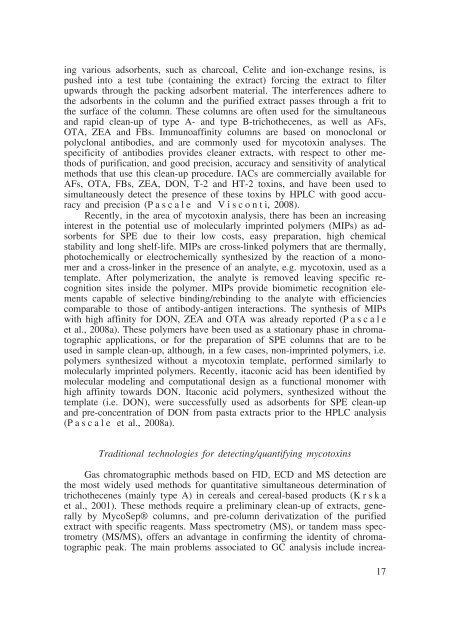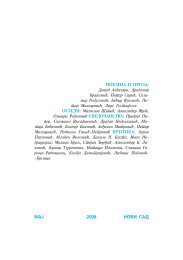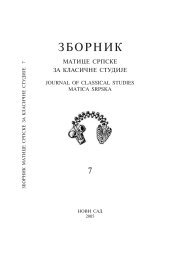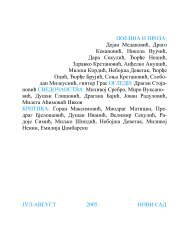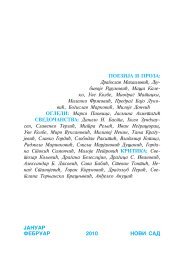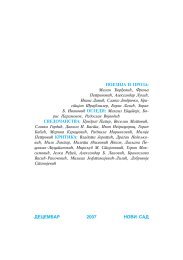ЗБОРНИК - Matica srpska
ЗБОРНИК - Matica srpska
ЗБОРНИК - Matica srpska
You also want an ePaper? Increase the reach of your titles
YUMPU automatically turns print PDFs into web optimized ePapers that Google loves.
ing various adsorbents, such as charcoal, Celite and ion-exchange resins, is<br />
pushed into a test tube (containing the extract) forcing the extract to filter<br />
upwards through the packing adsorbent material. The interferences adhere to<br />
the adsorbents in the column and the purified extract passes through a frit to<br />
the surface of the column. These columns are often used for the simultaneous<br />
and rapid clean-up of type A- and type B-trichothecenes, as well as AFs,<br />
OTA, ZEA and FBs. Immunoaffinity columns are based on monoclonal or<br />
polyclonal antibodies, and are commonly used for mycotoxin analyses. The<br />
specificity of antibodies provides cleaner extracts, with respect to other methods<br />
of purification, and good precision, accuracy and sensitivity of analytical<br />
methods that use this clean-up procedure. IACs are commercially available for<br />
AFs, OTA, FBs, ZEA, DON, T-2 and HT-2 toxins, and have been used to<br />
simultaneously detect the presence of these toxins by HPLC with good accuracy<br />
and precision (P a s c a l e and V i s c o n t i, 2008).<br />
Recently, in the area of mycotoxin analysis, there has been an increasing<br />
interest in the potential use of molecularly imprinted polymers (MIPs) as adsorbents<br />
for SPE due to their low costs, easy preparation, high chemical<br />
stability and long shelf-life. MIPs are cross-linked polymers that are thermally,<br />
photochemically or electrochemically synthesized by the reaction of a monomer<br />
and a cross-linker in the presence of an analyte, e.g. mycotoxin, used as a<br />
template. After polymerization, the analyte is removed leaving specific recognition<br />
sites inside the polymer. MIPs provide biomimetic recognition elements<br />
capable of selective binding/rebinding to the analyte with efficiencies<br />
comparable to those of antibody-antigen interactions. The synthesis of MIPs<br />
with high affinity for DON, ZEA and OTA was already reported (P a s c a l e<br />
et al., 2008a). These polymers have been used as a stationary phase in chromatographic<br />
applications, or for the preparation of SPE columns that are to be<br />
used in sample clean-up, although, in a few cases, non-imprinted polymers, i.e.<br />
polymers synthesized without a mycotoxin template, performed similarly to<br />
molecularly imprinted polymers. Recently, itaconic acid has been identified by<br />
molecular modeling and computational design as a functional monomer with<br />
high affinity towards DON. Itaconic acid polymers, synthesized without the<br />
template (i.e. DON), were successfully used as adsorbents for SPE clean-up<br />
and pre-concentration of DON from pasta extracts prior to the HPLC analysis<br />
(P a s c a l e et al., 2008a).<br />
Traditional technologies for detecting/quantifying mycotoxins<br />
Gas chromatographic methods based on FID, ECD and MS detection are<br />
the most widely used methods for quantitative simultaneous determination of<br />
trichothecenes (mainly type A) in cereals and cereal-based products (K r s k a<br />
et al., 2001). These methods require a preliminary clean-up of extracts, generally<br />
by MycoSep® columns, and pre-column derivatization of the purified<br />
extract with specific reagents. Mass spectrometry (MS), or tandem mass spectrometry<br />
(MS/MS), offers an advantage in confirming the identity of chromatographic<br />
peak. The main problems associated to GC analysis include increa-<br />
17


